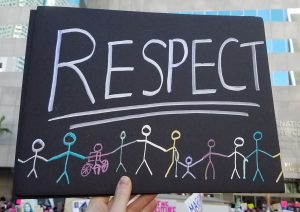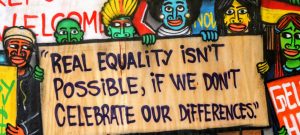…Hopefully For the Better
 Long gone are the days when leaders in any sector can afford to maintain narrow definitions of inclusion.
Long gone are the days when leaders in any sector can afford to maintain narrow definitions of inclusion.
Whether we’re talking about gender, sexual orientation, skin color, socio-economic background, culture, physical or cognitive abilities, religion or otherwise, we all have assumptions and unhelpful biases that can only be addressed when we’re aware that they are there in the first place — and choose to pay attention.
This post shares personal stories and revelations about working with transgender members of our community, exploring the question:
How can we widen the circle of who feels welcome in our schools, communities, and organizations?
About 5 years ago I had my first experience with an openly transgender 6 year old I’ll call Alex. This child was on a class field trip, had long sandy blonde hair, and identified as female. She was much more comfortable using the “girls” bathroom, and so I invited her in. Some of the other children in the class began complaining, saying that Alex was really a boy and shouldn’t be allowed in that bathroom.
Through all my years in education, I had neve r been in that situation before. I only knew a handful of transgender adults at the time, and had never met an openly trans child. How on earth could I talk about this skillfully with the other kids, whom I had only met an hour earlier? It was clear that Alex was already getting bullied. I had no training in how to be an ally under these circumstances. I fumbled and did my best, making sure she could safely use the bathroom without being tormented by the other children, but it felt wholly inadequate.
r been in that situation before. I only knew a handful of transgender adults at the time, and had never met an openly trans child. How on earth could I talk about this skillfully with the other kids, whom I had only met an hour earlier? It was clear that Alex was already getting bullied. I had no training in how to be an ally under these circumstances. I fumbled and did my best, making sure she could safely use the bathroom without being tormented by the other children, but it felt wholly inadequate.
Not long after this experience with Alex I met a young transgender man I’ll call Jay, who joined the organization’s internship program. Jay was beginning hormone replacement therapy that summer to align his outer appearance with his gender identity. Whether he meant to or not, he helped to shake things up.
 I was often misgendered as a young kid. I enjoyed having short hair like my two brothers, and was definitely a tomboy. Even so, it was always strange when someone called me “he” – it felt like they weren’t really seeing me. I didn’t like it.
I was often misgendered as a young kid. I enjoyed having short hair like my two brothers, and was definitely a tomboy. Even so, it was always strange when someone called me “he” – it felt like they weren’t really seeing me. I didn’t like it.
These memories came rushing back the first time I accidentally misgendered Jay. He took it in stride and politely corrected me, but I still felt like a jerk.
Note to self:
![]() Make mistakes and learn from them. It isn’t comfortable, but growth and comfort rarely have anything to do with each other…
Make mistakes and learn from them. It isn’t comfortable, but growth and comfort rarely have anything to do with each other…
Jay was a fantastic addition to the team, and inspired me to learn new ways to help the organization’s culture become more welcoming. He suggested simple things like making pronoun buttons available for staff to wear (if they wanted to), and introducing ourselves at meetings by proactively stating our preferred pronouns. Small changes like these go a long way toward signaling to transgender members of our community that they’re in a safe space.
 With Jay’s help, we developed and iterated the organization’s first Inclusion & Self-Expression professional development training. This led to more deeply developing other important PD’s such as Accessibility, empathy-based Customer Service trainings, and more. Although there’s still much to do (big and small), steps like this have the power to move organizations in a more inclusive and professionally reflective direction.
With Jay’s help, we developed and iterated the organization’s first Inclusion & Self-Expression professional development training. This led to more deeply developing other important PD’s such as Accessibility, empathy-based Customer Service trainings, and more. Although there’s still much to do (big and small), steps like this have the power to move organizations in a more inclusive and professionally reflective direction.
Even if you do not work in an organization that supports proactively inclusive efforts, each one of us can affect positive change:
What Can We Do?
Step 1 – Keep Learning
Want to learn more about transgender folks? Check out the resources below!
Step 2 – Reflect
–> What blind spots, assumptions, and biases do I have?
–> How might these impact the way I treat or understand others?
Two ways to explore these questions:
Freewrite and/or test for hidden bias.
Step 3 – Act!
How can we widen the circle of who feels welcome in our schools, communities, and organizations? It begins one interaction at a time.
Tips I’ve been given on how to be more welcoming to the transgender community:
-
- Don’t assume you know a person’s gender.
- Don’t assume that you know who does or does not identify as transgender.
- Listen or ask for people’s preferred pronouns, share your own, and correct yourself when you make a mistake.
- Remember, gender has nothing to do with sexual orientation.
- Talk less, listen more.
- Empathize – imagine yourself in other people’s shoes.
- Challenge ignorance and cruelty.
Thank you for taking the time to read this post. My journey is far from over, and I look forward to hearing more about your own.
What’s your perspective how to cultivate welcoming school, community, and organizational cultures? Share below!

Resources
- Tips for Allies of Transgender People
- About Transgender People (National Center for Transgender Equality)
- John Oliver’s 2015 episode on Transgender Rights (note: strong language)
- A Collection of TED Talks on the Topic of Transgender
- An Ally’s Guide to Terminology: Talking about LGBT People and Equality
- Read this HELPFUL GUIDE to understand the difference between biological sex, gender identity, sexual orientation and more. This guide comes from The Trevor Project, the leading national organization providing crisis intervention and suicide prevention services to LGBTQ people under the age of 25.
 twice as big and fast as us. I was the only girl in the game, and I was the last line of defense ahead of the goalie. We had 20 minutes left and the score was still zero to zero. Something had to give.
twice as big and fast as us. I was the only girl in the game, and I was the last line of defense ahead of the goalie. We had 20 minutes left and the score was still zero to zero. Something had to give. I wanted to disappear. The anger and embarrassment were crushing to little me, made worse by other boys on my team who made fun of me and said that girls shouldn’t play soccer.
I wanted to disappear. The anger and embarrassment were crushing to little me, made worse by other boys on my team who made fun of me and said that girls shouldn’t play soccer.
